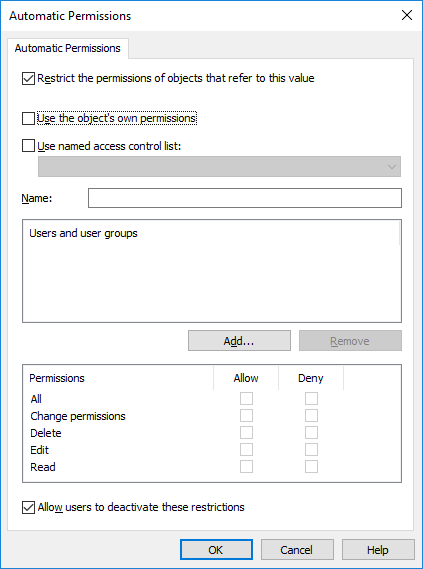Advanced object type properties
Defining an object type hierarchy
Object types can have hierarchical relationships. For example, the relationship between a customer company and its contact person can be defined so that the Contact Person object type is a subtype of the Customer object type. Viewing the value list for the Customer object type also displays the contact persons filtered by customer.
To define an object type hierarchy:
-
-
Do one or both of the following:
If you want to Do the following task Define subtypes for this object type Click the Add button, then select the object types to be added as subtypes of this object type, and click Add. Note: You can select more than one item at once. Hold down the Ctrl key to select multiple individual items or hold down the ⇧ Shift key to select adjacent items on the list.Note: To remove a subtype, click Remove.Define this object type as a subtype of another object type Select the This object type is a subtype of the following object type check box and select the object type from the drop-down menu. - Click OK.
Defining automatic permissions for an object type
An object receives automatic permissions when a value with automatic permissions is added to the object metadata. You can define automatic permissions for an object type so that when an object of the selected type is referred to in the metadata of another object, the object inherits the permissions of the object that it references.
To define automatic permissions for an object type:
-
- Click the Define button next to Default automatic permissions from this object type.
- Select the Restrict the permissions of objects that refer to this value check box to enable automatic permissions for the selected object type.
-
Do one of the following:
If you want to Do the following task Use the object permissions defined on the metadata card as automatic permissions
Select the Use the object's own permissions check box.
Use a predefined named access control list as automatic permissions
Select the Use named access control list check box and then select a predefined named access control list from the drop-down menu.
Use custom permission settings as automatic permissions
Click the Add button, then select the users or user groups to be added to the custom permission settings, and click Add.
Note: You can select more than one item at once. Hold down the Ctrl key to select multiple individual items or hold down the ⇧ Shift key to select adjacent items on the list.Note: To remove a user or group from the settings, click Remove.Select a user or group in the Users and user groups list and grant permissions in the Permissions list with the Allow and Deny check boxes.
- Optional: Select the Allow users to deactivate these restrictions check box if you want vault users to be able to disable the automatic permissions granted by these settings.
- Click OK to close the Automatic Permissions dialog.
- Back in the Object Type Properties dialog, click Apply or OK.
Using a Separate Metadata Search Index for an Object Type
You might want to enable the Use a separate metadata search index for this object type option for essential object types that are frequently used and that are found in large number in the vault.
Since these essential object types vary from organization to organization, the option is disabled by default. In document management, for example, the Document object type is naturally the most important object type. In CRM vaults, however, the most important object types are usually something different, such as Customer, Project, and Contact person.
If you select this option, M-Files uses a separate search structure for the objects of the selected object type. This improves search speed for both the objects of the selected object type and for other objects – especially if the vault contains a high number of objects representing this key object type.
To enable a separate metadata search index for an object type:
-
- Select the Use a separate metadata search index for this object type check box.
- Click OK.
Defining aliases for an object type
Aliases can be used for identifying semantically equivalent metadata. For example, when importing objects from another vault, their Date and Description properties can be mapped to the target vault's equivalent properties on the basis of aliases even if the properties' internal IDs, names, or both are different. That is, the aliases refer to semantically equivalent metadata in different vaults, or in other words, alias is a common ID for the same metadata definition between several vaults.
The alias is defined as a common ID with the same name in both source and target vault.
When you define the alias, you can use various external data type and archive standards, such as SÄHKE2, MoReq2, and Dublin Core.
For more information, see Associating the Metadata Definitions.
To define aliases for an object type:
-
-
In the Aliases field, enter the aliases for the selected object
type.
Use semicolons (;) to separate many aliases.Example:ObjectType.Customers; OT.CustomersWhen automatic aliases are in use and you enter a name on the General tab, the Aliases field on the Advanced tab is automatically filled in. The alias has the format <predefined prefix>.<name>. Configure automatic aliases for your vault in Advanced Vault Settings.
- Click OK.
